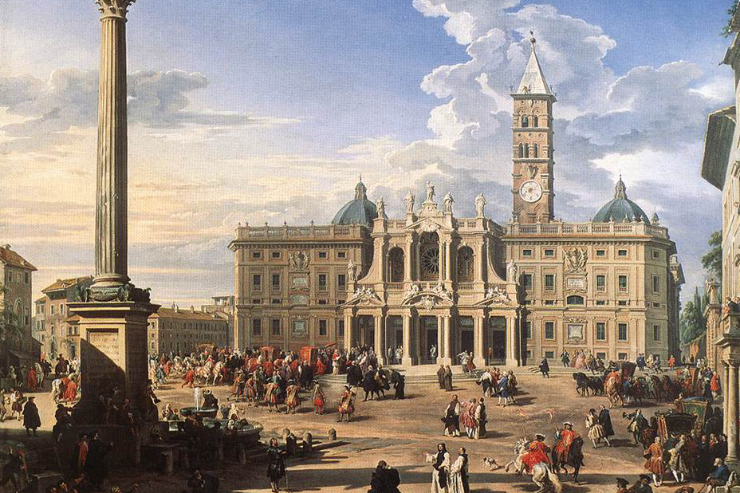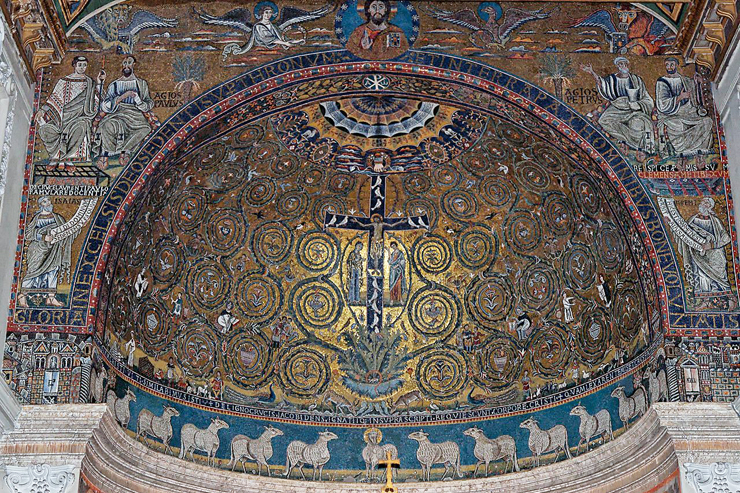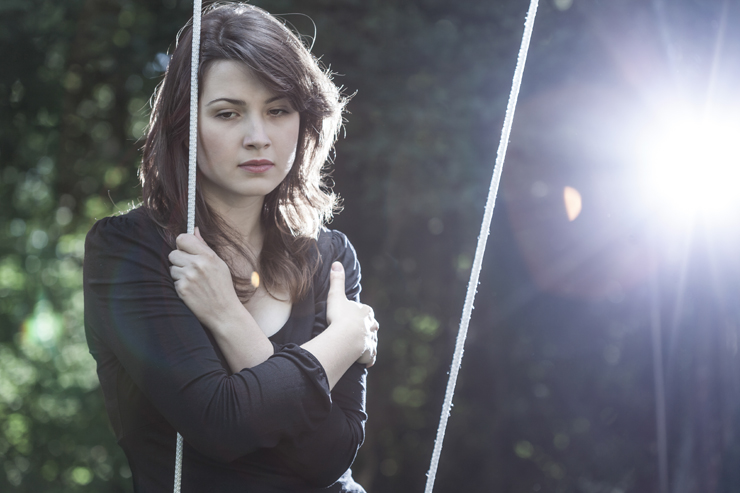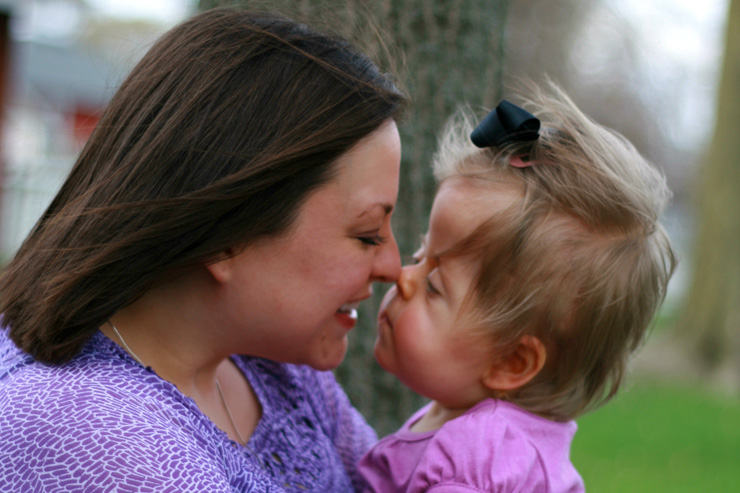
“The Piazza and Church of Santa Maria Maggiore” by Giovanni Paolo Pannini
It was a special Christmas. Our family, who lived fifteen hundred miles away, was coming to visit, and our almost-three-year-old daughter was beside herself. Santa took a back seat to her cousins, and with good reason.
We used the week together to make many memories and take hundreds of pictures. I remember the look of wonder on my nine-year-old niece’s face as she sat at midnight Mass, up later than she had ever been allowed to be before, with incense in the air and lights everywhere.
I will savor the memory of how my two-month-old infant was cuddled by her faraway aunt and how my older niece bonded with her. I’ll always remember how my younger niece and my older daughter clicked (and continue to click) and played each other to the very limit of their energies.
But the memory that continues to make me ponder, the one that I hold close to my heart and come back to, every so often, for inspiration and motivation, is the story of the snow.
My oldest niece, Mary, insisted that there must be snow for Christmas. Her family moved to the South when she was in grade school, and she missed the snow as much as she missed her cousins. Snow is something that just doesn’t happen where she lives. Her Christmas prayer was for snow.
Yes, that’s right: she prayed for snow. It seems silly, but we all smiled, and her enthusiasm was so great, I think we all secretly said a little prayer for snow too. How could we not?
And, two days after they arrived, on Christmas Eve, it started snowing. The forecast hadn’t called for snow. We weren’t expecting snow, though Mary maintained that there would be snow. We were inside, and I can’t remember how we knew it was snowing, whether someone came in from the barn and told us or if we looked out of a window, but all the kids whooped and hollered. They ran outside, Mary in front, to leap and galavant through the thick white flakes.
It’s wasn’t a flurry; it was a snowfall, as though someone had shaken a snow globe all around us. After a few minutes, the kids came back in and suited up more properly, with scarves and hats and mittens, and they took pictures.
Mary’s smile was huge. She must have said, “It’s SNOWING!” at least a hundred times that night. We echoed her, laughing. “It IS snowing!”
There’s something magical about snow, and it can’t just be because of the Christmas songs. In my part of Ohio, the snow seems to come in cycles; a few years of good snowfall, a few years of poor snowfall. Those cycles keep us from taking it too much for granted, I suppose, but there’s still something about that first snowfall, or snowfall that seems to mark a special occasion like Christmas or a birthday.
Our Lady of the Snows
In parts of the world where it doesn’t snow, I imagine their delight is greater than ours when it comes to snow. I imagine the shock—and the children’s shouts of glee—in Rome in the year 352 was much greater than my family’s.
Snow is a rare event in Rome, with many winters passing with no snow at all. When there is snow, the residents enjoy it at least as much as my nieces from the South enjoyed our Christmas snow in Ohio.
That snowfall in 352, though, happened in the heat of summer, on August 5, in answer to a childless couple’s prayer for Mary’s intercession.
The couple was pious, and I wonder if they longed for children the way so many couples I know do. I picture them, and they are an example to me of what to do when I don’t seem to be blessed in the way that I want to be: they talked to a priest—Pope Liberius, in fact—and on his counsel, took their petition to the Blessed Virgin Mary.
They were elderly, and had accepted their childless state. Though they had not been blessed with children, they were blessed with wealth, and since they had no heir, they wanted to use their significant fortune for God’s glory. It was this intention that they took to Mary, asking for a sign of what God wanted them to do.
Can you see Mary, so soon after her Son’s life and death, sitting in heaven and hearing this plea? I wonder if she smiled at their trust that she would guide them, if she felt proud of their openness to God’s will, if she did a little happy dance at having such a fun designation of funds.
What would you do with all that money? It was enough to build a church—should it go to the Church, to the poor, to a specific cause? With no one to leave it to, the couple could have had a vacation home and many more servants, a life of luxury and everything they desired.
Isn’t it just like a mother to think of some way of delighting her children? There they were, praying fervently and completely devoted to God’s will for their lives, asking for her help. And so, instead of just sending an answer in some commonplace manner, Mary arranged the sort of thing that delighted everyone.
Sometime during the night of August 4, snow fell in a specific spot on Esquiline Hill in Rome. It was in the shape of a church that was to be built in Mary’s honor.
Can’t you just hear the word spreading throughout the city during the early hours of the morning? August is a steamy time in Rome, and the snow, miraculously, did not melt immediately.
I think it probably started as a shocked sort of whisper, and then as a jolly shout, and then as a clamor of voices. The couple and Pope Liberius had had a dream through the night that Mary appeared and told them that Jesus’ will was that they use their treasure to finance building a church on Esquiline Hill, at a place they would see clearly marked in the morning.
They went to the spot and the pope arrived not long after them, in a solemn procession. The snow remained, despite the stifling temperatures, until the area was staked for the church.
Mary became, after that, Our Lady of the Snows, and the church that was built became known as Saint Mary Major, the first church—later a basilica—dedicated in her honor. It has been rebuilt and remains a place of pilgrimage in Rome.
Our Lady of the Snows reminds me that there’s nothing too small to pray for, to ask for God’s help with, to take the time to mention to God or Mary. She understands how much the small details matter and how big a difference the tiny parts of my life make to the final whole.
She doesn’t laugh when a young girl asks, so sincerely, for the gift of snow at Christmas. I think she probably smiled and savored the revelry that happened that Christmas Eve a couple of years ago. And all it took was snow.
Perhaps the lesson for me is to go to her, Our Lady of the Snows, when I’m filled with pain, when I’m longing to know God’s will. Like the couple from Rome over sixteen hundred years ago, I can offer my treasure—money, time, aptitude—and look for the direction she gives me. Maybe I’ll wake up to find the answer outlined as clear as snow.















